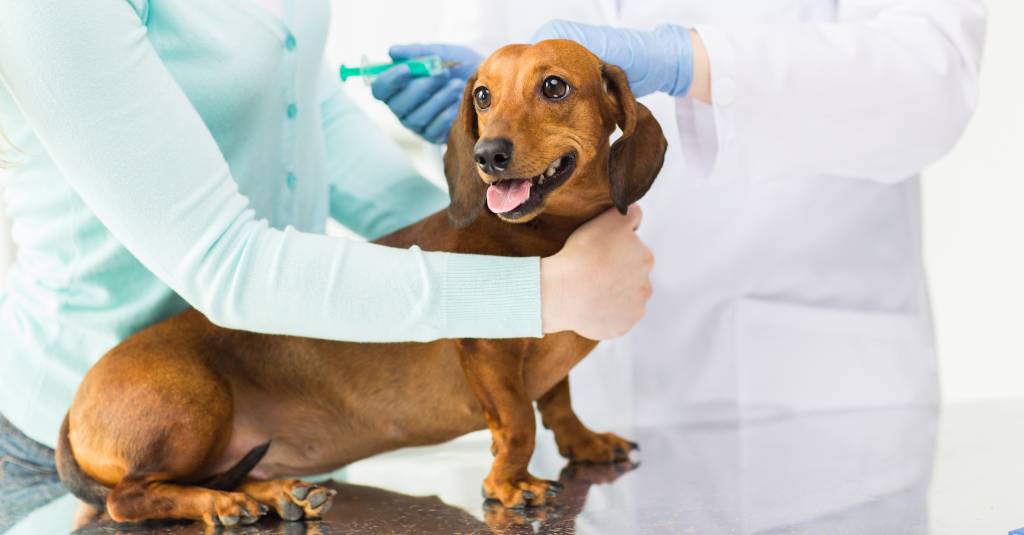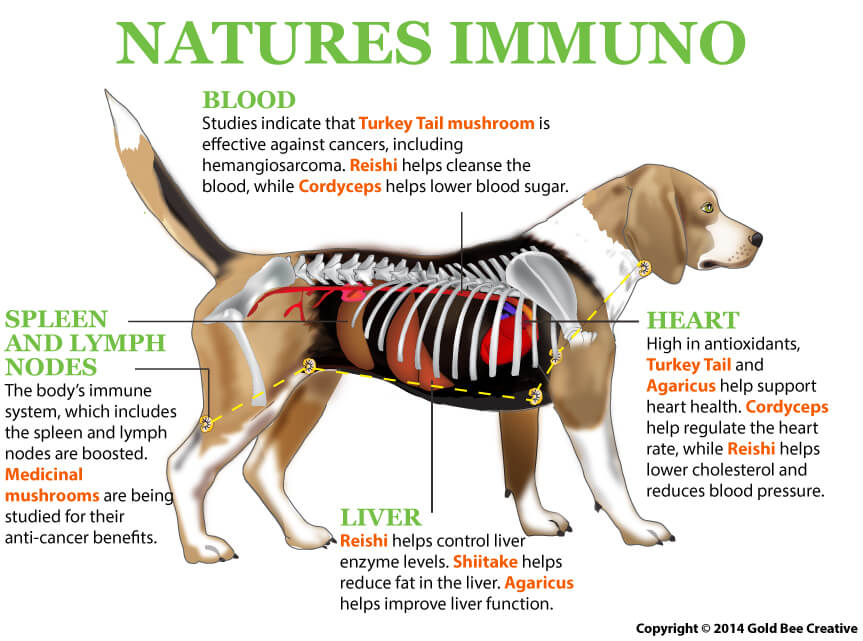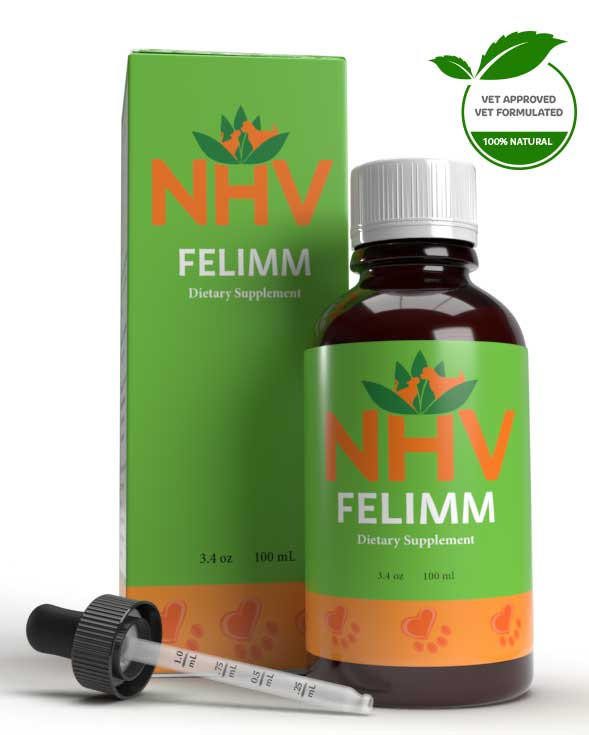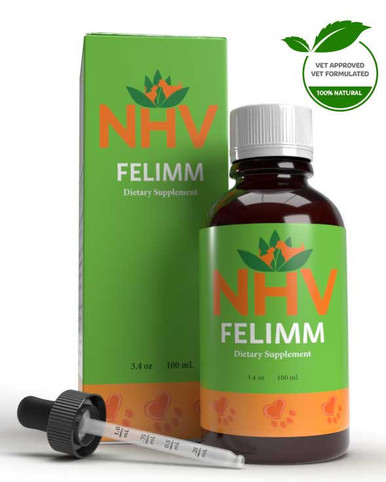liver support

free shipping over $100 (USA & Canada)
1-877-937-4372 the pet expert hotline

Lymphangiectasia in dogs is a condition that involves the lymphatic system. The lymphatic system plays a crucial role in transporting lymph and fluid that are important components in helping to fight infections and maintain fluid balance in the body. When lymphangiectasia happens, the lymphatic vessels become enlarged, and pets can develop digestive problems. As it can affect the body’s overall well-being, understanding how this condition impacts the lymphatic system and the digestive system is crucial.
Knowing some of the symptoms is very important as you can help your little one and look for medical help sooner than later. For example:
• Diarrhea: Instances may vary from mild to severe. It may be intermittent (stopping and returning in intervals).
• Weight Loss: Pets may lose body weight due to the malabsorption of nutrients.
• Swelling: Swelling may occur in the abdominal area, where fluid accumulates.
There are various causes that can lead to lymphangiectasia like genetic predisposition. For instance, certain breeds like Yorkshire Terriers and Basenjis may be more prone to have this condition. Evidence suggests that chronic inflammations, infectious diseases, and/or tumors also play a role on the development of lymphangiectasia in dogs.
Prompt consultation with a veterinarian is required when lymphangiectasia in dogs is suspected. Several diagnostic laboratory tests may help confirm the diagnosis:
• Blood Work: This helps to see if your fur baby has low protein levels for example.
• Imaging: Such as X-rays or ultrasounds can give a view of the organs in the abdomen and check for any anatomic abnormalities.
• Biopsy: In some cases, a tissue sample need to be collected and send to a pathologist to confirm lymphangiectasia and rule out other possible conditions such as lymphoma for example.
Note that having the correct diagnosis can help choosing the correct treatment plan and help improve the comfort and health outcomes of the pet.
Treating lymphangiectasia can include a combination of changes of many factors, such as changes in the diet, vet-prescribed medications, and supportive care such as supplements. Examples include:
• Changes in the diet: A diet low in fat content may help decrease the stress suffered by the lymphatic system. Some dogs also may benefit from a high quality digestible food that can support the absorption of nutrients
• Medications: Vet-prescribed medication may help manage the symptoms and reduce inflammation caused by this condition
In addition to traditional treatments, some supplements may provide valuable supportive care for various conditions including with lymphangiectasia. Here are some NHV supplements you should consider:
• NHV Milk Thistle: May support liver health, assisting in the detoxification.
• NHV Natures Immuno: For immune system support and overall health.
• NHV Felimm: May support the lymphatic system.
Herbal supplements offer supportive care when used alongside diet and lifestyle changes, as well as vet-prescribed medications.
Lymphangiectasia in dogs can be complex to manage and requires ongoing care, but the right supports can significantly improve the pet’s quality of life.
liver support

Support for liver and kidney detox and cancer support in dogs
3 month supply for a small to medium size pet
What Is It?
Milk Thistle for dogs is a gentle supplement that supports liver and kidney health, helps with detoxification, and provides antioxidant protection for long-term wellness.
How Does it Work?
Why Should I Trust It?
100% natural vet-formulated herbal remedy.


What Is It?
Milk Thistle for dogs is a gentle supplement that supports liver and kidney health, helps with detoxification, and provides antioxidant protection for long-term wellness.
How Does it Work?
Why Should I Trust It?
100% natural vet-formulated herbal remedy.

Milk Thistle is a powerful herb that’s been used by humans for thousands of years. The active ingredient, silymarin, has been shown through scientific studies to possess strong anti-inflammatory, antioxidant, and detoxifying properties. It also promotes cellular regeneration and repair.
This supplement by NHV Natural Pet Products uses 100% natural milk thistle to support dogs through liver and kidney conditions in addition to conventional treatment by their veterinarian.
Milk thistle improves kidney function due to the damage from:
The extraordinary antioxidant properties of milk thistle for dog extract acts to:
The scientific name for milk thistle is Silybum Marianum. It’s also referred to as wild artichoke and holy thistle.
Milk thistle for dog liver support can be used in conjunction with conventional treatments and is glycerin based and safe for long-term use. You can read more about the benefits of using milk thistle on Dr. Hillary Cook’s blog.
At NHV, all of our products including milk thistle for dog kidney support are plant-based and make excellent proactive support for many health conditions. If you have questions on milk thistle for dogs or any of our holistic supplements, you can ask an expert at NHV because we put your pet first when it comes to health and healing naturally.

Select your pet's weight to determine the correct dose.
To be taken twice daily. Determine your pet’s weight and then use the easy chart below to determine the correct dose. This is the minimum dosage.
Pet's Weight Dosage
0 - 15 lb = 0.5 ml
16 - 30 lb = 1.0 ml
31 - 45 lb = 1.5 ml
46 - 60 lb = 2.0 ml
61 - 75 lb = 2.5 ml
Over 75 lb = 3.0 ml
How to Administer
Shake well before use. The easiest method is to use the dropper provide and places the drops into your pet’s food or favorite treat. You can also use the dropper and squirt directly into the pet’s mouth.
Some pets can be finicky, if this occurs consider hiding the drops in foods most pet’s love such as fish, chicken or yogurt or a favourite treat. If your pet only eats dry food then soak a few kibbles at feeding time.
For Best Results
Herbal dietary supplements are beneficial to the health and wellbeing of your pet and are safe for long-term use. Every pet responds to natural herbal supplements differently, therefore it is important to be consistent and administer the product daily. Supplements generally take two to four weeks to take effect, however this will vary from one animal to the next.
Product Storage
All NHV Natural Pet Products are pure herbal extracts and contain no artificial additives, preservatives or coloring. Shelf life after opening is 6 months and must be refrigerated after opening.
Cautions and Contraindications
Do not use Milk Thistle in pregnant or nursing animals. Speak to your vet before using our products. A second visit is recommended if your pet’s condition does not improve, or deteriorates after continued use of the supplements.
All information provided by NHV Natural Pet Products is for educational purposes only.
Milk Thistle is a powerful herb that’s been used by humans for thousands of years. The active ingredient, silymarin, has been shown through scientific studies to possess strong anti-inflammatory, antioxidant, and detoxifying properties. It also promotes cellular regeneration and repair.
This supplement by NHV Natural Pet Products uses 100% natural milk thistle to support dogs through liver and kidney conditions in addition to conventional treatment by their veterinarian.
Milk thistle improves kidney function due to the damage from:
The extraordinary antioxidant properties of milk thistle for dog extract acts to:
The scientific name for milk thistle is Silybum Marianum. It’s also referred to as wild artichoke and holy thistle.
Milk thistle for dog liver support can be used in conjunction with conventional treatments and is glycerin based and safe for long-term use. You can read more about the benefits of using milk thistle on Dr. Hillary Cook’s blog.
At NHV, all of our products including milk thistle for dog kidney support are plant-based and make excellent proactive support for many health conditions. If you have questions on milk thistle for dogs or any of our holistic supplements, you can ask an expert at NHV because we put your pet first when it comes to health and healing naturally.

Select your pet's weight to determine the correct dose.
To be taken twice daily. Determine your pet’s weight and then use the easy chart below to determine the correct dose. This is the minimum dosage.
Pet's Weight Dosage
0 - 15 lb = 0.5 ml
16 - 30 lb = 1.0 ml
31 - 45 lb = 1.5 ml
46 - 60 lb = 2.0 ml
61 - 75 lb = 2.5 ml
Over 75 lb = 3.0 ml
How to Administer
Shake well before use. The easiest method is to use the dropper provide and places the drops into your pet’s food or favorite treat. You can also use the dropper and squirt directly into the pet’s mouth.
Some pets can be finicky, if this occurs consider hiding the drops in foods most pet’s love such as fish, chicken or yogurt or a favourite treat. If your pet only eats dry food then soak a few kibbles at feeding time.
For Best Results
Herbal dietary supplements are beneficial to the health and wellbeing of your pet and are safe for long-term use. Every pet responds to natural herbal supplements differently, therefore it is important to be consistent and administer the product daily. Supplements generally take two to four weeks to take effect, however this will vary from one animal to the next.
Product Storage
All NHV Natural Pet Products are pure herbal extracts and contain no artificial additives, preservatives or coloring. Shelf life after opening is 6 months and must be refrigerated after opening.
Cautions and Contraindications
Do not use Milk Thistle in pregnant or nursing animals. Speak to your vet before using our products. A second visit is recommended if your pet’s condition does not improve, or deteriorates after continued use of the supplements.
All information provided by NHV Natural Pet Products is for educational purposes only.
medicinal mushroom blend

Vet-Formulated Supplement of Medicinal Mushrooms for Dogs
buy 2 and save $3
3 month supply for a small to medium size pet
What Is It?
Natures Immuno is a natural supplement formulated for dogs from Turkey Tail, Cordyceps, Reishi, Shiitake, and Agaricus mushrooms.
How Does it Work?
Why Should I Trust It?
Formulated by a holistic veterinarian and master herbalist.


What Is It?
Natures Immuno is a natural supplement formulated for dogs from Turkey Tail, Cordyceps, Reishi, Shiitake, and Agaricus mushrooms.
How Does it Work?
Why Should I Trust It?
Formulated by a holistic veterinarian and master herbalist.

Natures Immuno is formulated for dogs from Turkey Tail, Cordyceps, Reishi, Shiitake, and Agaricus mushrooms by a holistic veterinarian and master herbalist. Medicinal mushrooms like these have been used for thousands of years in Chinese medicine as well as traditional herbalism. Researchers around the globe are now studying their potential in helping with cancer, balancing the immune system, and helping with digestive problems and more.
Natures Immuno Medicinal Mushroom blend for dogs also helps:
Medicinal mushrooms and mushroom extracts are used worldwide to help fight cancer and to help enhance and modulate the immune response of both people and animals. NHV’s mushroom blend contains 5 species of medicinal mushrooms for dogs, which have a long history of use, are well studied, and have been credited with having success against cancer as well as having antioxidant, hypocholesterolemia, anti-tumor, immunomodulatory, anti-allergic, nephroprotective, prebiotic, immunostimulant, anti-inflammatory, cardiovascular, and anti-diabetic properties
Properties of these Medicinal Mushrooms
Benefits of Natures Immuno Medicinal Mushrooms Blend for Dogs
You can read more about medicinal mushrooms for dogs and how they help give added support to pets for cancer and immunity.
NHV carries a wide range of holistic, natural vet-approved remedies that provide support along with a vet-recommended treatment plan. If you have questions about any of our plant-based supplements, ask an NHV expert, because, at NHV, we want your pet to live healthier and longer naturally.

Turkey Tail mushroom is native to Asia, North America, and Europe. It has a long history of use in traditional herbalism and is currently being studied for its health benefits, including its value in fighting cancer. Research has shown that Turkey Tail is beneficial for many types of cancer as it contains properties that help fight cancer cells while helping to strengthen the immune system. Turkey tail mushroom for dogs has shown to be beneficial in spleen and liver hemangiosarcoma in dogs. It is also useful for heart health, lowering cholesterol, digestive issues, and skin problems.
Cordyceps mushroom is very rich in phytonutrients. Research has indicated that these mushrooms demonstrate anti-tumor, immune enhancing and hypoglycemic activity. It has anti-inflammatory, antioxidant, anti-tumor, anti-cancer, antimetastatic, and antiviral properties. It is very useful for diabetes as it helps lower blood sugar. Cordyceps also help enhance lymphocyte activity, which balance the immune system.
Reishi mushroom has been used for thousands of years in traditional Chinese medicine. It helps detoxify the blood, helps lower cholesterol and reduces blood pressure. It is also beneficial for the lymphatic system, which helps with a dog’s immunity.
Shiitake mushroom is a popular ingredient in cooking and is highly valued in traditional herbalism for its immune stimulating properties. It helps reduce fat in the liver, helps lower cholesterol, and is beneficial for heart health as it aids in reducing plaque in the arteries. Shiitake may help inhibit the growth of leukemia cells. Shiitake is also a good source of protein, vitamins, and minerals.
Agaricus mushroom is cultivated widely for dietary supplements and culinary purposes. Agaricus is useful for bone health, and helps with insulin production and helps with liver function. Agaricus is considered an adaptogen, which helps combat stress and supports the endocrine functions. This mushroom is currently used in Japan as an adjunctive with chemotherapy treatments.
Select your pet's weight to determine the correct dose.
To be taken twice daily.
Determine your pet’s weight and then use the easy chart below to determine the correct dose. You can safely double the recommended dosage.
Pet's Weight Dosage
0 - 15 lb 0.5 mL
16 - 30 lb 1.0 mL
31 - 45 lb 1.5 mL
46 - 60 lb 2.0 mL
61 - 75 lb 2.5 mL
Over 75 lb 3.0 mL
For small animals (rabbits, ferrets), avians and reptiles use 1 drop for every 2 lb of body weight.
How to Administer
Shake well before use. The easiest method is to use the dropper provided and place the drops into your pet’s food or favorite treat. You can also use the dropper and squirt directly into the pet’s mouth. Some pets can be finicky, if this occurs consider hiding the drops in foods most pet’s love such as fish, chicken, yogurt, or a favorite treat. If your pet only eats dry food then soak a few kibbles at feeding time.
For Best Results
Herbal dietary supplements are beneficial to the health and well-being of your pet and are safe for long-term use. Every pet responds to natural herbal supplements differently, therefore it is important to be consistent and administer the product daily. Supplements generally take two to four weeks to take effect, however this will vary from one animal to the next.
Product Storage
All NHV Natural Pet Products are pure herbal extracts and contain no artificial additives, preservatives or coloring. Shelf life after opening is 6 months and must be refrigerated after opening.
Natures Immuno is formulated for dogs from Turkey Tail, Cordyceps, Reishi, Shiitake, and Agaricus mushrooms by a holistic veterinarian and master herbalist. Medicinal mushrooms like these have been used for thousands of years in Chinese medicine as well as traditional herbalism. Researchers around the globe are now studying their potential in helping with cancer, balancing the immune system, and helping with digestive problems and more.
Natures Immuno Medicinal Mushroom blend for dogs also helps:
Medicinal mushrooms and mushroom extracts are used worldwide to help fight cancer and to help enhance and modulate the immune response of both people and animals. NHV’s mushroom blend contains 5 species of medicinal mushrooms for dogs, which have a long history of use, are well studied, and have been credited with having success against cancer as well as having antioxidant, hypocholesterolemia, anti-tumor, immunomodulatory, anti-allergic, nephroprotective, prebiotic, immunostimulant, anti-inflammatory, cardiovascular, and anti-diabetic properties
Properties of these Medicinal Mushrooms
Benefits of Natures Immuno Medicinal Mushrooms Blend for Dogs
You can read more about medicinal mushrooms for dogs and how they help give added support to pets for cancer and immunity.
NHV carries a wide range of holistic, natural vet-approved remedies that provide support along with a vet-recommended treatment plan. If you have questions about any of our plant-based supplements, ask an NHV expert, because, at NHV, we want your pet to live healthier and longer naturally.

Turkey Tail mushroom is native to Asia, North America, and Europe. It has a long history of use in traditional herbalism and is currently being studied for its health benefits, including its value in fighting cancer. Research has shown that Turkey Tail is beneficial for many types of cancer as it contains properties that help fight cancer cells while helping to strengthen the immune system. Turkey tail mushroom for dogs has shown to be beneficial in spleen and liver hemangiosarcoma in dogs. It is also useful for heart health, lowering cholesterol, digestive issues, and skin problems.
Cordyceps mushroom is very rich in phytonutrients. Research has indicated that these mushrooms demonstrate anti-tumor, immune enhancing and hypoglycemic activity. It has anti-inflammatory, antioxidant, anti-tumor, anti-cancer, antimetastatic, and antiviral properties. It is very useful for diabetes as it helps lower blood sugar. Cordyceps also help enhance lymphocyte activity, which balance the immune system.
Reishi mushroom has been used for thousands of years in traditional Chinese medicine. It helps detoxify the blood, helps lower cholesterol and reduces blood pressure. It is also beneficial for the lymphatic system, which helps with a dog’s immunity.
Shiitake mushroom is a popular ingredient in cooking and is highly valued in traditional herbalism for its immune stimulating properties. It helps reduce fat in the liver, helps lower cholesterol, and is beneficial for heart health as it aids in reducing plaque in the arteries. Shiitake may help inhibit the growth of leukemia cells. Shiitake is also a good source of protein, vitamins, and minerals.
Agaricus mushroom is cultivated widely for dietary supplements and culinary purposes. Agaricus is useful for bone health, and helps with insulin production and helps with liver function. Agaricus is considered an adaptogen, which helps combat stress and supports the endocrine functions. This mushroom is currently used in Japan as an adjunctive with chemotherapy treatments.
Select your pet's weight to determine the correct dose.
To be taken twice daily.
Determine your pet’s weight and then use the easy chart below to determine the correct dose. You can safely double the recommended dosage.
Pet's Weight Dosage
0 - 15 lb 0.5 mL
16 - 30 lb 1.0 mL
31 - 45 lb 1.5 mL
46 - 60 lb 2.0 mL
61 - 75 lb 2.5 mL
Over 75 lb 3.0 mL
For small animals (rabbits, ferrets), avians and reptiles use 1 drop for every 2 lb of body weight.
How to Administer
Shake well before use. The easiest method is to use the dropper provided and place the drops into your pet’s food or favorite treat. You can also use the dropper and squirt directly into the pet’s mouth. Some pets can be finicky, if this occurs consider hiding the drops in foods most pet’s love such as fish, chicken, yogurt, or a favorite treat. If your pet only eats dry food then soak a few kibbles at feeding time.
For Best Results
Herbal dietary supplements are beneficial to the health and well-being of your pet and are safe for long-term use. Every pet responds to natural herbal supplements differently, therefore it is important to be consistent and administer the product daily. Supplements generally take two to four weeks to take effect, however this will vary from one animal to the next.
Product Storage
All NHV Natural Pet Products are pure herbal extracts and contain no artificial additives, preservatives or coloring. Shelf life after opening is 6 months and must be refrigerated after opening.
immune support

Natural herbal supplement to help your dog fight many viral, fungal, and bacterial related infections.
buy 2 and save $3
3 month supply for a small to medium size pet.
What is it?
Felimm helps your pup fight a variety of fungal and viral infections. This infection remedy for dogs helps combat Canine Herpesvirus, Canine Influenza, Lyme disease, Staphylococcal Bacterial, Ehrlichiosis, Aspergillosis, Blastomycosis Cryptococcus, Valley Fever, and yeast infections.
How Does it Work?
Why Should I Trust It?
Formulated with powerful, yet gentle herbs.


What is it?
Felimm helps your pup fight a variety of fungal and viral infections. This infection remedy for dogs helps combat Canine Herpesvirus, Canine Influenza, Lyme disease, Staphylococcal Bacterial, Ehrlichiosis, Aspergillosis, Blastomycosis Cryptococcus, Valley Fever, and yeast infections.
How Does it Work?
Why Should I Trust It?
Formulated with powerful, yet gentle herbs.

Dogs can get viral, fungal, and bacterial infections of many kinds. Canine herpesvirus, Canine influenza, Lyme disease, Staphylococcal bacterial, Ehrlichiosis, Aspergillosis, Blastomycosis Cryptococcus, Valley Fever, and yeast infections just to name a few. Felimm is a natural vet-formulated remedy that helps support your dog’s body and helps them fight back against all of these conditions. Add Felimm canine infection remedy to the regimen prescribed by your vet to give them the most comprehensive possible care.
Felimm is an infection remedy for dogs with many ingredients that have strong antiviral properties. Turmeric, Aloe Vera, St. John’s Wort, and Myrrh have antiseptic, antibacterial, antiviral, and anti-inflammatory qualities that help make Felimm a powerful remedy to support your dog against a variety of conditions.
Viruses, as well as fungal and bacterial infections, can harm your dog’s immune system and affect the function of other organs. Some of these viruses, such as canine herpesvirus (CHV) or canine influenza virus, affect the respiratory and reproductive system. Felimm is also an excellent support supplement for pets fighting lymphoma.
To help your pet heal, it is important to support the affected organs and balance their immune system. NHV Felimm contains a variety of potent herbs that help support and defend the body against viral, fungal, and bacterial infections while boosting the immune system and detoxifying the lymph nodes.
NHV Felimm can help with Lyme disease in dogs and cats - a bacterial infection transmitted by ticks. This dog infection remedy can also help with Cryptococcus, a fungal infection caused by environmental yeast.
NHV’s holistic pet products contain human-grade herbal ingredients. All of our supplements are vet-approved and specially formulated by a veterinarian and master herbalist with over 20 years of experience.
Call the NHV pet expert hotline at 1-877-937-4327 to learn about our dog infection treatment aids.
St. John’s Wort – A herb known to have strong antiviral, immunostimulant, anti-inflammatory, antiretroviral and antibacterial properties. St. John’s Wort has a history of use to help the body fight the herpes virus, as well as viral hepatitis and HIV. It helps with inhibiting the reproduction of the viruses and has been shown to be beneficial for canine distemper.
Turmeric – A very powerful antioxidant that helps combat the damaging effects of free radicals. It strengthens liver function and contains strong antifungal properties.
Aloe Vera – Helps control fungal infections, and helps improve white blood cell counts which helps destroy infectious organisms. An herb that is known for its immunostimulating, antibacterial, antitumor, and anti-inflammatory properties.
Alfalfa – An extremely nutritious herb that is high in minerals, amino acids, a good source of chlorophyll, and high in antioxidants.
Burdock – Is an herb and a food that is very nutritive as it contains high levels of minerals such as iron and calcium. Strong antiviral properties support the liver and gallbladder, and help clean and improve the quality of blood. It helps remove toxins that accumulate during illness and helps scavenge free radicals from a dog’s body.
Cat’s Claw – Has traditionally been used in herbal medicine to treat the herpes virus and other related viral infections due to properties that help balance the immune system while fighting off infections and inflammation.
Osha – Used for centuries to help fight viral infections that affect the respiratory system. It helps to relieve inflammation of the bronchial tube, relax the muscles, and stops bacteria and viruses from spreading. A natural immune builder that helps dogs fight infections and helps improve immune function.
Dandelion – A highly nutritious food that stimulates liver secretion, protects the kidneys, improves digestion, and stimulates appetite. It helps provide a pet’s body with the vitamins and minerals needed when fighting an infection. It is known to help reduce inflammation.
Gotu Kola – An antioxidant-rich herb known to strengthen the immune system and protect cells from damage caused by free radicals. It helps calm the nervous system to reduce the added stress canines exhibit when fighting infections. It is also used to help with respiratory issues.
Usnea – An immune system stimulant with antibacterial and antifungal properties that helps protect a dog’s suppressed immune system from respiratory and sinus infections, bronchial issues, canine influenza, and herpes virus. It helps boost and restore proper immune function.
Goldenseal – An herb known for improving immune function. It helps eliminate toxins from the blood. It has strong fungal fighting properties and is used when dealing with Candida and thrush in dogs.
Myrrh – a medicinal herb that dates back to 1550 BC. Considered to be a natural antibiotic, antiviral, and astringent herb. It strengthens and improves the immune system and helps fight infections.
Select your pet's weight to determine the correct dose.
To be taken twice daily. Determine your pet’s weight and then use the easy chart below to determine the correct dose. This is the minimum dosage.
Pet's Weight Dosage
0 - 15 lb = 0.5 ml
16 - 30 lb = 1.0 ml
31 - 45 lb = 1.5 ml
46 - 60 lb = 2.0 ml
61 - 75 lb = 2.5 ml
Over 75 lb = 3.0 ml
How to Administer
Shake well before use. The easiest method is to use the dropper provided and place the drops into your pet’s food or favorite treat. You can also use the dropper and squirt directly into the pet’s mouth. Some pets can be finicky, if this occurs consider hiding the drops in foods most pet’s love such as fish, chicken or yogurt or a favorite treat. If your pet only eats dry food then soak a few kibbles at feeding time.
For Best Results
Herbal dietary supplements are beneficial to the health and well-being of your pet and are safe for long-term use. Every pet responds to natural herbal supplements differently, therefore it is important to be consistent and administer the product daily. Supplements generally take two to four weeks to take effect, however this will vary from one animal to the next.
Product Storage
All NHV Natural Pet Products are pure herbal extracts and contain no artificial additives, preservatives or coloring. Shelf life after opening is 6 months and must be refrigerated after opening.
Cautions and Contraindications
Do not use Felimm in pregnant or nursing animals. Speak to your vet before using our products. A second visit is recommended if your pet’s condition does not improve, or deteriorates after continued use of the supplements.
All information provided by NHV Natural Pet Products is for educational purposes only.
Dogs can get viral, fungal, and bacterial infections of many kinds. Canine herpesvirus, Canine influenza, Lyme disease, Staphylococcal bacterial, Ehrlichiosis, Aspergillosis, Blastomycosis Cryptococcus, Valley Fever, and yeast infections just to name a few. Felimm is a natural vet-formulated remedy that helps support your dog’s body and helps them fight back against all of these conditions. Add Felimm canine infection remedy to the regimen prescribed by your vet to give them the most comprehensive possible care.
Felimm is an infection remedy for dogs with many ingredients that have strong antiviral properties. Turmeric, Aloe Vera, St. John’s Wort, and Myrrh have antiseptic, antibacterial, antiviral, and anti-inflammatory qualities that help make Felimm a powerful remedy to support your dog against a variety of conditions.
Viruses, as well as fungal and bacterial infections, can harm your dog’s immune system and affect the function of other organs. Some of these viruses, such as canine herpesvirus (CHV) or canine influenza virus, affect the respiratory and reproductive system. Felimm is also an excellent support supplement for pets fighting lymphoma.
To help your pet heal, it is important to support the affected organs and balance their immune system. NHV Felimm contains a variety of potent herbs that help support and defend the body against viral, fungal, and bacterial infections while boosting the immune system and detoxifying the lymph nodes.
NHV Felimm can help with Lyme disease in dogs and cats - a bacterial infection transmitted by ticks. This dog infection remedy can also help with Cryptococcus, a fungal infection caused by environmental yeast.
NHV’s holistic pet products contain human-grade herbal ingredients. All of our supplements are vet-approved and specially formulated by a veterinarian and master herbalist with over 20 years of experience.
Call the NHV pet expert hotline at 1-877-937-4327 to learn about our dog infection treatment aids.
St. John’s Wort – A herb known to have strong antiviral, immunostimulant, anti-inflammatory, antiretroviral and antibacterial properties. St. John’s Wort has a history of use to help the body fight the herpes virus, as well as viral hepatitis and HIV. It helps with inhibiting the reproduction of the viruses and has been shown to be beneficial for canine distemper.
Turmeric – A very powerful antioxidant that helps combat the damaging effects of free radicals. It strengthens liver function and contains strong antifungal properties.
Aloe Vera – Helps control fungal infections, and helps improve white blood cell counts which helps destroy infectious organisms. An herb that is known for its immunostimulating, antibacterial, antitumor, and anti-inflammatory properties.
Alfalfa – An extremely nutritious herb that is high in minerals, amino acids, a good source of chlorophyll, and high in antioxidants.
Burdock – Is an herb and a food that is very nutritive as it contains high levels of minerals such as iron and calcium. Strong antiviral properties support the liver and gallbladder, and help clean and improve the quality of blood. It helps remove toxins that accumulate during illness and helps scavenge free radicals from a dog’s body.
Cat’s Claw – Has traditionally been used in herbal medicine to treat the herpes virus and other related viral infections due to properties that help balance the immune system while fighting off infections and inflammation.
Osha – Used for centuries to help fight viral infections that affect the respiratory system. It helps to relieve inflammation of the bronchial tube, relax the muscles, and stops bacteria and viruses from spreading. A natural immune builder that helps dogs fight infections and helps improve immune function.
Dandelion – A highly nutritious food that stimulates liver secretion, protects the kidneys, improves digestion, and stimulates appetite. It helps provide a pet’s body with the vitamins and minerals needed when fighting an infection. It is known to help reduce inflammation.
Gotu Kola – An antioxidant-rich herb known to strengthen the immune system and protect cells from damage caused by free radicals. It helps calm the nervous system to reduce the added stress canines exhibit when fighting infections. It is also used to help with respiratory issues.
Usnea – An immune system stimulant with antibacterial and antifungal properties that helps protect a dog’s suppressed immune system from respiratory and sinus infections, bronchial issues, canine influenza, and herpes virus. It helps boost and restore proper immune function.
Goldenseal – An herb known for improving immune function. It helps eliminate toxins from the blood. It has strong fungal fighting properties and is used when dealing with Candida and thrush in dogs.
Myrrh – a medicinal herb that dates back to 1550 BC. Considered to be a natural antibiotic, antiviral, and astringent herb. It strengthens and improves the immune system and helps fight infections.
Select your pet's weight to determine the correct dose.
To be taken twice daily. Determine your pet’s weight and then use the easy chart below to determine the correct dose. This is the minimum dosage.
Pet's Weight Dosage
0 - 15 lb = 0.5 ml
16 - 30 lb = 1.0 ml
31 - 45 lb = 1.5 ml
46 - 60 lb = 2.0 ml
61 - 75 lb = 2.5 ml
Over 75 lb = 3.0 ml
How to Administer
Shake well before use. The easiest method is to use the dropper provided and place the drops into your pet’s food or favorite treat. You can also use the dropper and squirt directly into the pet’s mouth. Some pets can be finicky, if this occurs consider hiding the drops in foods most pet’s love such as fish, chicken or yogurt or a favorite treat. If your pet only eats dry food then soak a few kibbles at feeding time.
For Best Results
Herbal dietary supplements are beneficial to the health and well-being of your pet and are safe for long-term use. Every pet responds to natural herbal supplements differently, therefore it is important to be consistent and administer the product daily. Supplements generally take two to four weeks to take effect, however this will vary from one animal to the next.
Product Storage
All NHV Natural Pet Products are pure herbal extracts and contain no artificial additives, preservatives or coloring. Shelf life after opening is 6 months and must be refrigerated after opening.
Cautions and Contraindications
Do not use Felimm in pregnant or nursing animals. Speak to your vet before using our products. A second visit is recommended if your pet’s condition does not improve, or deteriorates after continued use of the supplements.
All information provided by NHV Natural Pet Products is for educational purposes only.